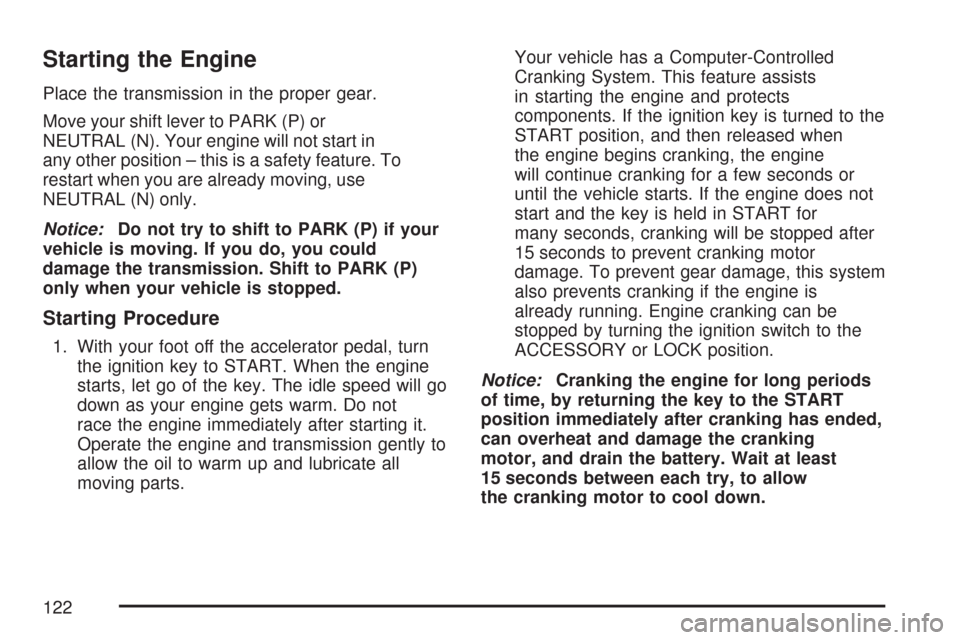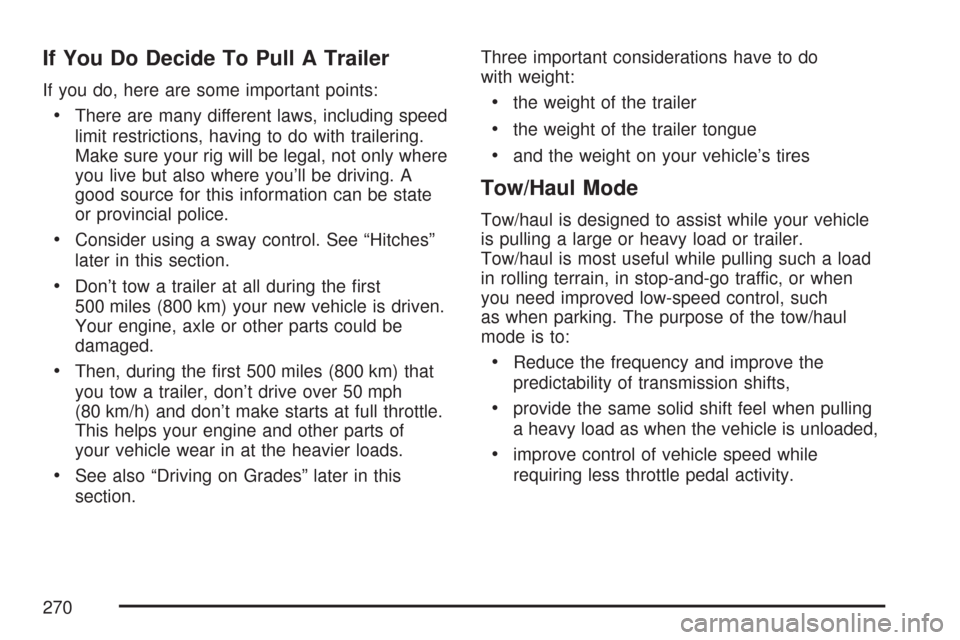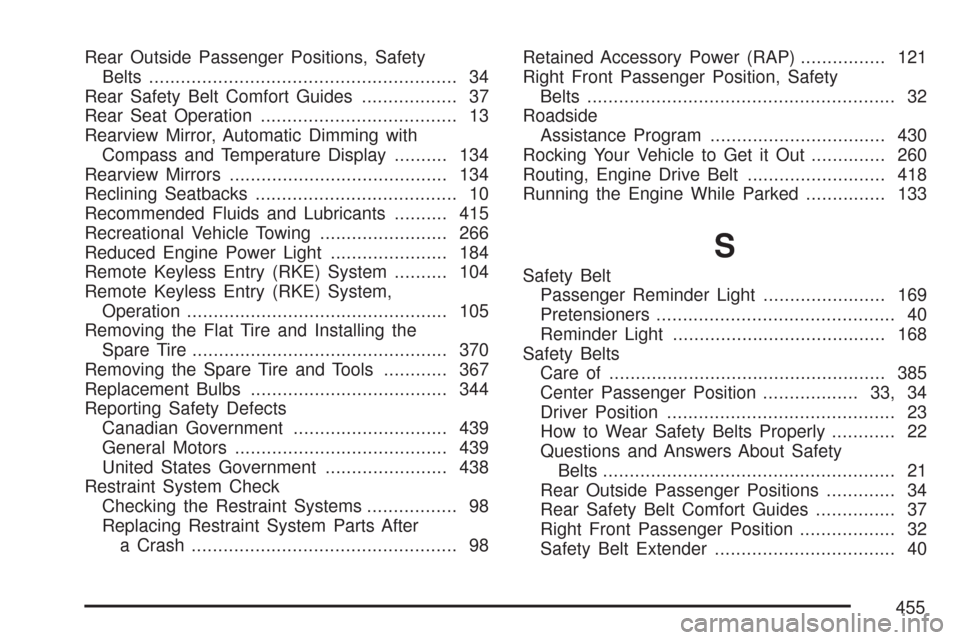Page 122 of 458

Starting the Engine
Place the transmission in the proper gear.
Move your shift lever to PARK (P) or
NEUTRAL (N). Your engine will not start in
any other position – this is a safety feature. To
restart when you are already moving, use
NEUTRAL (N) only.
Notice:Do not try to shift to PARK (P) if your
vehicle is moving. If you do, you could
damage the transmission. Shift to PARK (P)
only when your vehicle is stopped.
Starting Procedure
1. With your foot off the accelerator pedal, turn
the ignition key to START. When the engine
starts, let go of the key. The idle speed will go
down as your engine gets warm. Do not
race the engine immediately after starting it.
Operate the engine and transmission gently to
allow the oil to warm up and lubricate all
moving parts.Your vehicle has a Computer-Controlled
Cranking System. This feature assists
in starting the engine and protects
components. If the ignition key is turned to the
START position, and then released when
the engine begins cranking, the engine
will continue cranking for a few seconds or
until the vehicle starts. If the engine does not
start and the key is held in START for
many seconds, cranking will be stopped after
15 seconds to prevent cranking motor
damage. To prevent gear damage, this system
also prevents cranking if the engine is
already running. Engine cranking can be
stopped by turning the ignition switch to the
ACCESSORY or LOCK position.
Notice:Cranking the engine for long periods
of time, by returning the key to the START
position immediately after cranking has ended,
can overheat and damage the cranking
motor, and drain the battery. Wait at least
15 seconds between each try, to allow
the cranking motor to cool down.
122
Page 270 of 458

If You Do Decide To Pull A Trailer
If you do, here are some important points:
•There are many different laws, including speed
limit restrictions, having to do with trailering.
Make sure your rig will be legal, not only where
you live but also where you’ll be driving. A
good source for this information can be state
or provincial police.
•Consider using a sway control. See “Hitches”
later in this section.
•Don’t tow a trailer at all during the first
500 miles (800 km) your new vehicle is driven.
Your engine, axle or other parts could be
damaged.
•Then, during the first 500 miles (800 km) that
you tow a trailer, don’t drive over 50 mph
(80 km/h) and don’t make starts at full throttle.
This helps your engine and other parts of
your vehicle wear in at the heavier loads.
•See also “Driving on Grades” later in this
section.Three important considerations have to do
with weight:
•the weight of the trailer
•the weight of the trailer tongue
•and the weight on your vehicle’s tires
Tow/Haul Mode
Tow/haul is designed to assist while your vehicle
is pulling a large or heavy load or trailer.
Tow/haul is most useful while pulling such a load
in rolling terrain, in stop-and-go traffic, or when
you need improved low-speed control, such
as when parking. The purpose of the tow/haul
mode is to:
•Reduce the frequency and improve the
predictability of transmission shifts,
•provide the same solid shift feel when pulling
a heavy load as when the vehicle is unloaded,
•improve control of vehicle speed while
requiring less throttle pedal activity.
270
Page 455 of 458

Rear Outside Passenger Positions, Safety
Belts.......................................................... 34
Rear Safety Belt Comfort Guides.................. 37
Rear Seat Operation..................................... 13
Rearview Mirror, Automatic Dimming with
Compass and Temperature Display.......... 134
Rearview Mirrors......................................... 134
Reclining Seatbacks...................................... 10
Recommended Fluids and Lubricants.......... 415
Recreational Vehicle Towing........................ 266
Reduced Engine Power Light...................... 184
Remote Keyless Entry (RKE) System.......... 104
Remote Keyless Entry (RKE) System,
Operation................................................. 105
Removing the Flat Tire and Installing the
Spare Tire................................................ 370
Removing the Spare Tire and Tools............ 367
Replacement Bulbs..................................... 344
Reporting Safety Defects
Canadian Government............................. 439
General Motors........................................ 439
United States Government....................... 438
Restraint System Check
Checking the Restraint Systems................. 98
Replacing Restraint System Parts After
a Crash.................................................. 98Retained Accessory Power (RAP)................ 121
Right Front Passenger Position, Safety
Belts.......................................................... 32
Roadside
Assistance Program................................. 430
Rocking Your Vehicle to Get it Out.............. 260
Routing, Engine Drive Belt.......................... 418
Running the Engine While Parked............... 133
S
Safety Belt
Passenger Reminder Light....................... 169
Pretensioners............................................. 40
Reminder Light........................................ 168
Safety Belts
Care of.................................................... 385
Center Passenger Position.................. 33, 34
Driver Position........................................... 23
How to Wear Safety Belts Properly............ 22
Questions and Answers About Safety
Belts....................................................... 21
Rear Outside Passenger Positions............. 34
Rear Safety Belt Comfort Guides............... 37
Right Front Passenger Position.................. 32
Safety Belt Extender.................................. 40
455